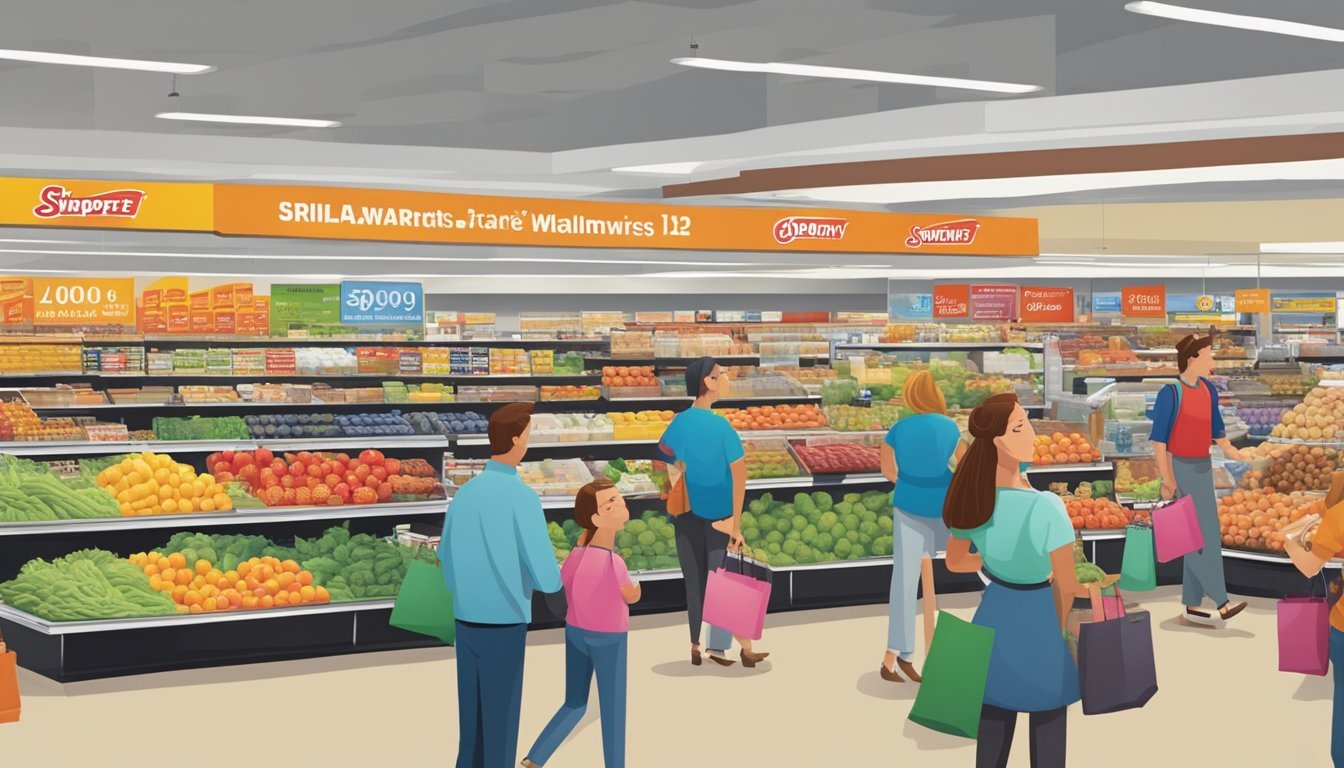Shoprite vs Walmart
A Comprehensive Comparison of Prices, Selection, and Service
When it comes to grocery shopping, consumers often face a choice between ShopRite and Walmart. These two retail giants offer distinct experiences for customers seeking to fill their pantries and refrigerators. ShopRite, a cooperative of independent grocery stores, primarily operates in the northeastern United States. Walmart, on the other hand, is a global retail corporation with a massive presence across the country.
Both ShopRite and Walmart have their strengths, but Walmart tends to offer lower overall prices on groceries. A comparison of grocery baskets revealed that Walmart's total came to $119.44, while other major chains had higher prices. This price advantage makes Walmart an attractive option for budget-conscious shoppers. However, price isn't everything when it comes to grocery shopping.
ShopRite distinguishes itself with a focus on local communities and a wider selection of specialty items. The cooperative structure allows individual stores to cater to regional preferences and offer unique products. Additionally, both supermarkets have adapted to changing consumer needs by providing grocery delivery and pickup services, with varying fee structures and minimum order requirements.
Company Backgrounds
Walmart and ShopRite represent two distinct approaches to grocery retail in the United States. Both have deep roots in American commerce, but their paths to success have differed significantly.
Shoprite's History and Presence
ShopRite began as a cooperative of independent grocers in 1946. Based in New Jersey, it grew from eight small retailers banding together to form the Wakefern Food Corporation. This cooperative structure allowed ShopRite to compete with larger chains while maintaining local ownership.
ShopRite operates primarily in the northeastern United States. The company has built a reputation for quality products and competitive pricing. Its stores often feature a mix of national brands and ShopRite's own private label items.
Walmart's Expansion and Dominance
Founded in 1962 by Sam Walton in Arkansas, Walmart started as a single discount store. The company rapidly expanded across the USA, becoming the world's largest retailer by revenue.
Walmart entered the grocery market in the 1980s with its Supercenters. These massive stores combine general merchandise with full grocery departments. The company's size allows it to negotiate lower prices from suppliers, often undercutting competitors.
Walmart's grocery division now includes neighborhood markets and online delivery services. The retail giant operates in all 50 states and has a significant international presence.
Store Offerings and Services
ShopRite and Walmart offer diverse product ranges and services to meet customers' grocery needs. Both stores provide various departments and brand options, but they differ in their focus and specialties.
Diversity of Products
ShopRite boasts a wide selection of groceries, including fresh produce, meats, and dairy. Their produce section often features local and seasonal items. Walmart's supercenters carry an extensive range of products beyond groceries, including clothing, electronics, and household goods.
ShopRite typically offers a larger variety of specialty and gourmet items. Walmart, while having a broad selection, tends to focus more on everyday staples and popular brands.
Both stores stock frozen foods, canned goods, and pantry essentials. However, ShopRite often has a more extensive selection of international and ethnic foods.
Specialty Departments
ShopRite stores usually have well-developed specialty departments. Their bakeries offer fresh-baked breads, cakes, and pastries. The deli counters provide a variety of meats, cheeses, and prepared foods.
Many ShopRite locations feature full-service seafood departments with fresh and frozen options. Their meat departments often include butcher services and a range of cuts.
Walmart's specialty departments vary by location. Some supercenters have bakeries and delis, but they may not be as extensive as ShopRite's. Walmart's seafood offerings are typically more limited, focusing on popular items and frozen options.
Brands and Label Options
Both stores offer a mix of national brands and private label products. ShopRite's store brand, "ShopRite," covers a wide range of products and is known for its quality and value.
Walmart's private labels include "Great Value" for groceries and household items, and "Marketside" for fresh foods. These brands are often priced lower than national brands.
ShopRite typically carries more premium and specialty brands. Walmart focuses on offering the most popular national brands alongside their budget-friendly store options.
Both retailers stock organic products, with ShopRite often having a larger selection of organic produce and specialty organic brands. Walmart's organic offerings have expanded in recent years, particularly in their "Great Value Organic" line.
Price Comparison and Value
Walmart and ShopRite employ distinct pricing strategies and offer various ways for customers to save money on groceries. Their approaches to pricing, deals, and loyalty programs significantly impact the overall value shoppers receive.
Overall Pricing Policies
Walmart is known for its "Everyday Low Prices" strategy, aiming to provide consistently low prices across its product range. This approach often results in Walmart offering lower base prices on many items compared to ShopRite. A typical grocery basket at Walmart can cost around $119.44, making it one of the most affordable options for shoppers.
ShopRite, on the other hand, may have slightly higher base prices but compensates with frequent sales and promotions. This dynamic pricing strategy can lead to significant savings for savvy shoppers who plan their purchases around these deals.
Deals and Savings
Both stores offer various ways for customers to save money, but their approaches differ:
Walmart:
Rollback prices on select items
Clearance deals
Digital coupons through the Walmart app
ShopRite:
Weekly circular deals
Digital and paper coupons
"Can Can Sale" and other seasonal promotions
ShopRite's sales can sometimes make their prices comparable to or even lower than Walmart's, especially on produce items. For example:
Item Walmart Price ShopRite Price (with sale) Apples $1.29/lb $0.99/lb Oranges $0.69 each $0.50 each Bell Peppers $0.98 each $0.75 each
Loyalty and Reward Programs
Walmart and ShopRite both offer loyalty programs to enhance customer value:
Walmart+:
Free delivery on orders $35+
Fuel discounts
Scan & Go for in-store shopping
Early access to deals
Costs $12.95/month or $98/year
ShopRite Price Plus:
Free to join
Digital coupons
Personalized deals
Gas rewards at participating stations
ShopRite's program is more accessible as it's free, while Walmart+ offers additional perks for a fee. The choice between these programs depends on individual shopping habits and preferences.
Shopping Experience and Customer Service
Shoprite and Walmart offer distinct shopping experiences, with each retailer focusing on different aspects of customer service and store atmosphere. The layout, cleanliness, and staff interactions shape how customers perceive and navigate these grocery stores.
In-Store Navigation and Layout
Walmart's stores typically feature wide aisles and clear signage, making it easy for customers to find what they need. The supercenters often have a logical flow, with groceries on one side and general merchandise on the other. Shoprite stores tend to be more compact, with a focus on grocery items. Their layouts can vary by location but generally group similar products together for convenient shopping.
Both chains use end-cap displays and promotional areas to highlight deals. Walmart's size can sometimes make product location challenging, while Shoprite's smaller footprint may lead to more crowded aisles during peak times.
Customer Service Quality
Shoprite often emphasizes personalized customer service, with staff trained to assist shoppers and answer product-related questions. Many Shoprite stores are independently owned, which can result in a more localized approach to customer care.
Walmart, being a larger corporation, may have a more standardized customer service approach. While this ensures consistency across stores, it can sometimes feel less personal. Both retailers offer self-checkout options, but Walmart has been more aggressive in implementing this technology.
Wait times at checkout can vary, with Walmart's higher traffic sometimes leading to longer lines despite having more registers.
Cleanliness and Store Atmosphere
Shoprite stores generally maintain a clean and well-organized appearance. The company often focuses on creating a welcoming atmosphere with bright lighting and well-stocked shelves. Some locations feature in-store cafes or seating areas, adding to the shopping experience.
Walmart's cleanliness can vary by location, but the company has made efforts to improve store conditions in recent years. The sheer size of Walmart supercenters can make maintaining a consistently tidy appearance more challenging.
Both retailers strive to keep their produce sections fresh and appealing. Shoprite often features local produce, which can contribute to a farmers' market feel in some stores. Walmart's produce sections are typically larger but may lack the same personalized touch.
Accessibility and Convenience
ShopRite and Walmart offer different advantages in terms of accessibility and convenience for grocery shoppers. Their store locations and delivery services impact how easily customers can access their products and services.
Store Locations and Geographic Reach
ShopRite operates primarily in the northeastern United States, with over 300 stores across six states. This regional focus allows ShopRite to cater to local preferences and maintain a strong presence in specific areas.
Walmart, on the other hand, boasts a much larger national footprint with over 4,700 stores across the United States. This extensive network makes Walmart more accessible to a wider range of customers across the country.
For shoppers in the Northeast, both stores may be viable options. However, customers outside this region will likely find Walmart more convenient due to its broader geographic reach.
Delivery Services and Online Shopping
Both retailers have embraced online shopping and grocery delivery to meet evolving consumer needs. ShopRite's delivery service charges a flat $10 fee with no minimum order requirement, offering flexibility for small purchases.
Walmart's delivery fees range from $7.95 to $9.95, depending on the chosen time slot. A $30 minimum order is required. Walmart also offers a Delivery Unlimited membership for $12.95 monthly or $98 annually, providing free unlimited delivery for frequent shoppers.
Both stores allow customers to place orders online for home delivery or in-store pickup. This convenience caters to busy schedules and those who prefer to avoid in-store shopping.
Consumer Engagement and Loyalty
Walmart and ShopRite employ distinct strategies to foster customer loyalty and engagement. These approaches cater to different consumer demographics and preferences, shaping their respective market positions.
Loyalty Program Structures
Walmart's loyalty program, Walmart+, offers a suite of benefits. Members enjoy free shipping on online orders, fuel discounts, and early access to promotions. The program costs $98 annually or $12.95 monthly.
ShopRite's Price Plus card provides a more traditional loyalty structure. It's free to join and offers digital coupons, personalized deals, and points on purchases. These points can be redeemed for discounts on groceries or gas.
Walmart's program focuses on integrating online and in-store experiences. ShopRite's approach emphasizes savings on everyday grocery purchases.
Demographics and Target Customers
Walmart caters to a broad customer base, appealing to budget-conscious shoppers across various income levels. Its vast product range attracts families, young professionals, and seniors alike.
ShopRite targets a more regional demographic, primarily in the Northeast. It focuses on middle-income families and individuals seeking value without compromising quality. ShopRite's local ownership model allows stores to tailor offerings to community preferences.
Both retailers adapt their engagement strategies to their target markets. Walmart leverages its scale for nationwide promotions, while ShopRite often creates localized campaigns and events to connect with customers.
Sustainability and Ethical Practices
Both ShopRite and Walmart have implemented sustainability initiatives and ethical practices in their operations. These efforts focus on environmental stewardship and responsible sourcing throughout their supply chains.
Environmental Initiatives
ShopRite has taken steps to reduce food waste in its stores. The company donates over 5,000 tons of fresh food annually to local food banks and charities. Inedible food is composted rather than sent to landfills.
Walmart has set ambitious environmental goals. The company aims to achieve zero emissions across its global operations by 2040. Walmart also plans to protect, manage, or restore at least 50 million acres of land and 1 million square miles of ocean by 2030.
Both retailers offer organic food options to customers seeking more sustainable choices. However, Walmart's larger scale allows it to offer organic products at lower prices in many cases.
Supply Chain Ethics
Walmart has implemented programs to improve working conditions in its supply chain. The company requires suppliers to meet ethical standards and conducts thousands of factory audits each year.
ShopRite, as a cooperative of independent retailers, emphasizes supporting local farmers and producers. This localized supply chain can provide greater transparency and connection to food sources.
Regarding sustainable seafood, Walmart partners with environmental organizations to ensure its fish is responsibly sourced. ShopRite also offers sustainably caught seafood options, though on a smaller scale.
Market Presence and Competition
Walmart and ShopRite are major players in the grocery retail industry, competing for market share alongside other prominent chains. Their positioning and strategies differ, as do the strengths of their various competitors.
Competitive Positioning
Walmart holds a dominant position in the U.S. retail market, leveraging its vast network of stores and e-commerce capabilities. The company's everyday low pricing strategy attracts budget-conscious shoppers. ShopRite, while smaller in scale, maintains a strong regional presence in the Northeast.
ShopRite's cooperative structure allows individual store owners to tailor offerings to local preferences. This gives them an advantage in customer service and community engagement. Walmart counters with its extensive product selection and integrated online shopping options.
Other Competitors in the Market
The grocery landscape is highly competitive, with numerous chains vying for consumer dollars. Amazon-owned Whole Foods targets health-conscious shoppers with premium organic products. Aldi and Lidl challenge both Walmart and ShopRite on price, offering no-frills shopping experiences.
Target has expanded its grocery offerings, appealing to shoppers seeking convenience and style. Regional powerhouses like Wegmans, Publix, and Kroger compete on quality and customer service. Trader Joe's carves out a niche with unique private-label products.
Discount chains like Food Lion and specialty retailers such as Sprouts Farmers Market further fragment the market. Each competitor brings distinct strengths, forcing Walmart and ShopRite to continuously innovate and adapt their strategies.
Special Features and Programs
ShopRite and Walmart offer unique features and programs to attract and retain customers. Both retailers have developed exclusive product lines and innovative marketing strategies to differentiate themselves in the competitive grocery market.
Exclusive Brands and Products
ShopRite's Bowl & Basket and Paperbird private label brands provide high-quality, affordable alternatives to national brands. These exclusive lines cover a wide range of products, from pantry staples to household essentials. ShopRite also offers a selection of gourmet cheeses and specialty items under its ShopRite Trading Company brand.
Walmart's Great Value and Equate private labels are well-known for their low prices and extensive product range. The retailer has expanded its exclusive offerings to include organic and premium options like Sam's Choice. Walmart's private brands cover everything from groceries to electronics.
Innovative Marketing Initiatives
ShopRite's digital coupons program allows customers to load deals directly onto their Price Plus club card. The retailer's mobile app provides personalized offers and easy shopping list creation. ShopRite's "Potluck" blog and podcast offer recipes, cooking tips, and lifestyle content to engage customers beyond the store.
Walmart's Savings Catcher program automatically compares prices with local competitors and refunds the difference. The Walmart+ membership program provides benefits like free delivery, mobile scan-and-go shopping, and fuel discounts. Walmart's TikTok presence and shoppable livestreams on social media platforms showcase its innovative approach to digital marketing.
Conclusion
Shoprite and Walmart both offer competitive options for grocery shoppers. Walmart generally provides lower prices overall, with savings that can add up significantly over time. Their extensive product selection and convenient delivery options are notable advantages.
Shoprite shines in its focus on fresh produce and customer service. Many shoppers appreciate the quality of Shoprite's store-brand items and their weekly sales. The store's community involvement is also a positive factor for some customers.
Price-conscious consumers may find Walmart more appealing, especially for bulk purchases or household goods. Those prioritizing freshness and a more traditional grocery experience often prefer Shoprite.
The choice between these two stores ultimately depends on individual priorities. Budget, product quality, store atmosphere, and convenience all play roles in the decision. Some shoppers may even split their purchases between both stores to maximize benefits.
Both Walmart and Shoprite continue to adapt to changing consumer needs, improving their online services and expanding their offerings. As competition in the grocery sector intensifies, customers stand to benefit from ongoing improvements and competitive pricing at both retailers.









